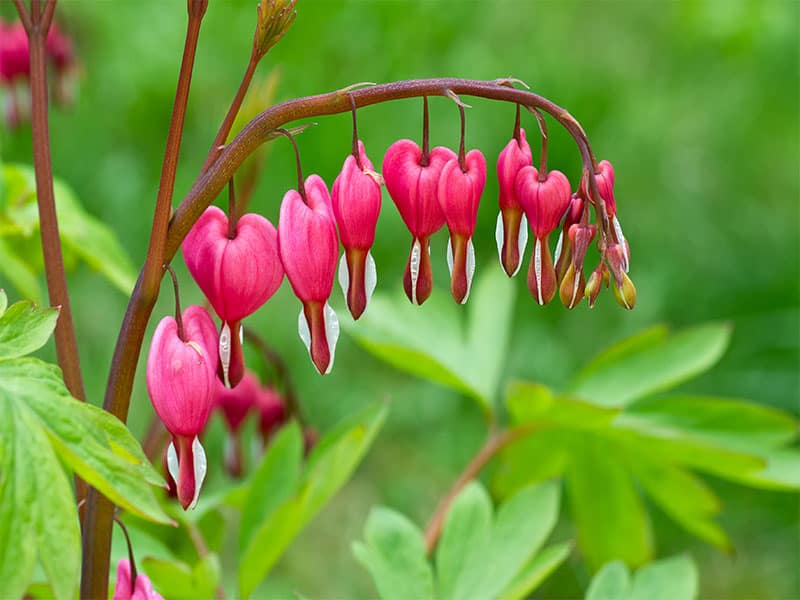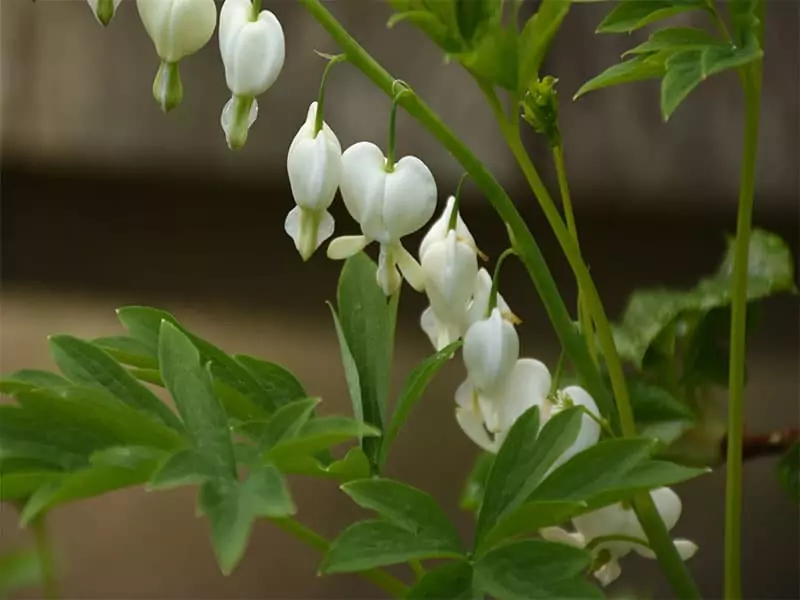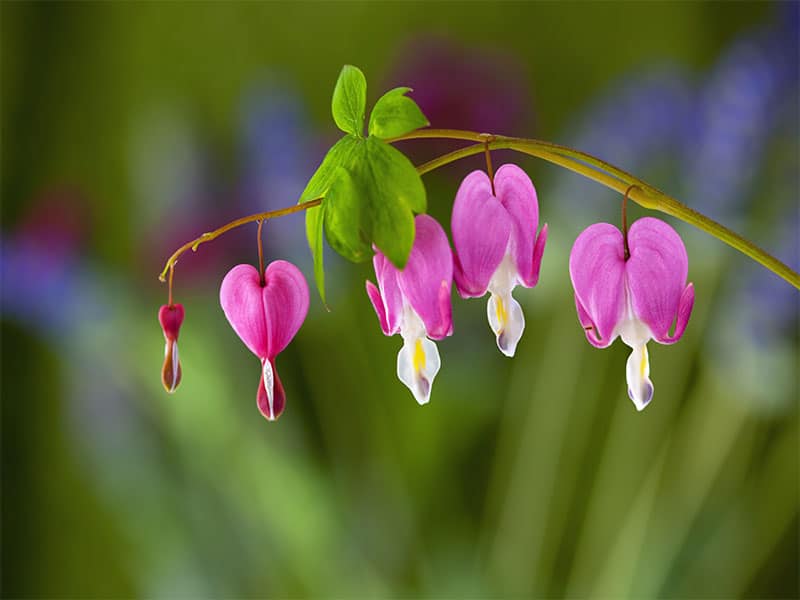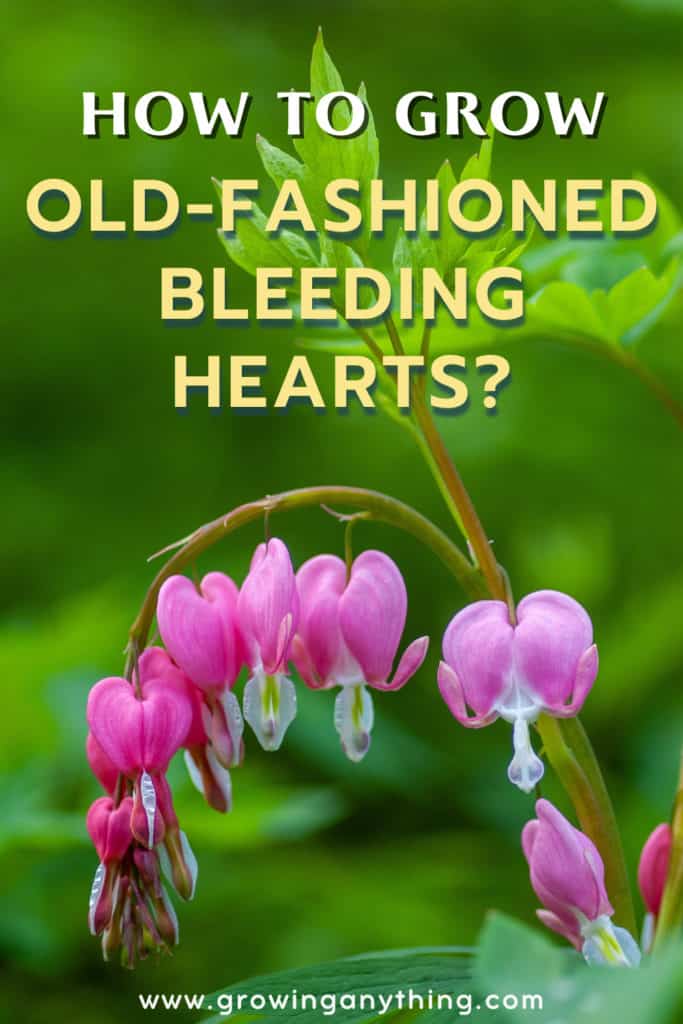How To Grow Old-Fashioned Bleeding Hearts?
It is very easy to see how the old-fashioned bleeding heart flower got its name. The flower shape is similar to a heart with an additional pendulous drop that is dangling. These shade-loving flowers are perfect for just about any garden, blooming in early spring and staying in bloom for several weeks.
During summer, it is likely that this flower will not bloom if it is exposed to full sun or too much heat. Once the weather is colder and there is more shade available to it, it will come to life once again. However, some varieties of the flower bloom throughout the summer.
Many things need to be taken into consideration before someone commits to planting old-fashioned bleeding hearts. I will tell you more about the characteristics of this amazing flower and how to grow it. Without further ado, let’s get right into it!

Bleeding Heart Varieties
Bleeding heart is an umbrella term used for several varieties of this plant. Most of them bloom in spring and spend the summer lying dormant. However, if they receive proper care, they might flower throughout the summer and fall.
Most of the varieties of this plant grow up to 36 inches, but some can reach a height of 3 feet. Let’s go over some of the most common varieties of this plant:
Lamprocapnos Spectabilis (Gold Heart)
This variety of the plant should be planted in partial or full shade. Its usual blooming period is in late spring and its flowers are in vibrant pink color with a white center. Sometimes, its foliage can be golden.
Lamprocapnos Spectabilis (Alba)
Even though the name of this variety is the same as the above-mentioned, the difference is in the flower. The flowers of this variety are pure white and they bloom during the summer. When the flowers are cut, they can stay fresh for additional two weeks.
Dicentra Eximia
This is a slightly different variety of the plant. It has pink flowers and foliage leaves that stay fresh even during the summer.
Dicentra Luxuriant
Known as one of the smaller varieties of this plant, the dicentra luxuriant can only reach a height of 15 inches. Its flowers are pink and they bloom during both spring and fall. This variant of the plant is known to thrive both in hotter and colder weather.
Dicentra Formosa (Burning Hearts)
This is the best variety of the plant if you are looking to keep it in a container. It can only reach a height of 10 inches and it has red flowers.
Dicentra Cucullaria (Dutchmans’ Breeches)
Yet another compact variety of the plant. The flowers on it are mostly white, and they tend to bloom during spring and summer.
How To Grow Bleeding Hearts?
Before planting the seeds or cuttings of bleeding hearts, you need to make sure that the soil is organic, well-drained, and that it has enough moisture at all times. The plant also likes to be in the shade, so placing it in a sunny spot in your garden will not allow it to grow as you would want it to.
It could be a good idea to add compost to the soil before planting the bleeding hearts. If that is not an option for you, then you can always try with any other type of organic mulch that will help the soil get more nutrients.
As I have already mentioned, the bleeding heart flowers tend to bloom during spring or fall but not during summer. Those couple of months, the plant dies into the ground but when it starts to wither, it is trying to store food reserves that it will use during the next blooming period.
With this plant, it is also a good idea to give it fertilizer during the growing period because it will benefit it greatly. The additional nutrients will help keep the blooms looking better and staying longer.
The flower does not require any special maintenance and its growing process is very simple. Give them enough water, shade, fertilizer, and allow them to have enough space to grow.

How To Care For Bleeding Hearts?
During one blooming period, a single bleeding heart plant will have around 20 small flowers that will grow from its stem. The flowers are very delicate and do not like the sun or the wind. So, you should do your best to protect them from any extreme weather conditions.
Here are some pointers that might come in handy when it comes to caring for bleeding heart flowers!
Light
Bleeding hearts do not like to be exposed to full sun. It is best to plant them near a tree that would keep them in shade for much of their blooming period.
Soil
The soil in which you plant bleeding hearts should be rich with humus, moist at all times, with a lot of organic matter. The pH of the soil does not play a part in the growth of the flowers, so there is no need to worry about it.
When you first plant the flowers, you can add a few layers of organic matter just to give the flowers enough nutrients. This will also help with aeration and will allow the roots to grow faster.
Water
During summer and when the weather is extremely hot, the flowers will require a lot of water to stay alive. It is common for them to disappear during the summer and re-appear in fall or spring.
If you plant the flowers during the summer, make sure to mark the spot so you do not forget where you have planted them during their dormant period. Also, make sure that you provide them with a moist environment but do not go over the top with the water.
Temperature and Humidity
The reason why the bleeding hearts disappear during the summer is that they are storing their energy away for the winter period. You will usually find them blooming when the temperature is around 55 or 75 degrees Fahrenheit.
When it comes to humidity, these flowers can thrive in humid weather. They like to have water available to them, but too much water will not be good for their growth.
Fertilizer
Even though they do not need a lot of food, the bleeding hearts will benefit from fertilizer-rich soil. However, if the soil is organic naturally, you will not need to add fertilizer to it.
In case you are wondering, one of the best foods that you can give to this plant is leaf mold. This will keep them thriving all year round.
Toxicity
Bleeding hearts are known to be toxic. If eaten, they can cause serious liver damage or even seizures.
While there are not many cases of poisoning in people, these flowers are known to cause regular problems to animals like dogs and cats. When in contact with them, people can also experience some skin irritation or maybe even skin rash.
How To Propagate Bleeding Hearts?
The old-fashioned bleeding hearts have a special charm to them, which is why many people want to add them to their garden. While I already discussed some of the basics when it comes to taking care of these flowers, I will now mention when you should propagate them and how to go about this process!
When Is The Right Time To Propagate Bleeding Hearts?
After a couple of years of life, the bleeding hearts tend to slow down. This would be the best time to try propagating them by dividing them. It will not only rejuvenate the plant but also allow new stems from it to grow.
The best time to start dividing the flowers is in spring or fall. On the other hand, if propagating using seeds, you will need to do it in late summer. Yet another way to propagate them is by transplanting them or taking cuttings from them.
Propagating Bleeding Hearts With Seeds
Planting bleeding heart seeds is very easy. The soil should be slightly moist before the seeds are planted, and you should consider adding some peat and vermiculite to the soil. Add them to the soil and cover them with another layer of soil.
If you are planting them in a pot, you should add them to a container first, wrap the container in plastic and keep it in the freezer for six weeks. Then, let the container germinate for another month before you transplant the seeds to a regular pot.
Propagating Bleeding Hearts With Division
This type of propagation should happen every five weeks. You should dig the plant carefully and calmly divide the plant into thirds or half. Then, add every part into a separate container with moist soil.
Keep them in the container for some time before transplanting them to another pot or flowerbed. Too many changes at once might not be good for the flower.
Propagating Bleeding Hearts With Cuttings
Before taking cuttings from the plant’s roots, you should make sure that it has enough water. Finding a healthy root is crucial and will give you the best chance of propagating new bleeding hearts.
First off, you need to rinse the root and find any growth nodes that it might have. Separate only that part of the root that has two nodes. Once you have the cuttings, you should add them to some pre-moistened sand and add a bit of material to them.
Keep them in the sand for at least a few weeks, give them enough water and keep them away from full light. In six weeks tops, you will see the first sprouts coming from the cuttings.
How To Treat Yellow Bleeding Hearts?
When it does not have the proper growing conditions, the bleeding heart plant is known to start going yellow. A bleeding heart with yellow leaves points to something being wrong with the plant.
If you are noticing that your bleeding hearts are going yellow, then stay tuned to learn more about what the problem with them might be!
Natural Yellowing
The bleeding hearts do not like hot temperatures. They bloom in spring and start dying down in summer. At the beginning of summer, it is normal for the flower to start going yellow – this means that it is preparing to lay dormant before blooming again.
Not Enough Water
If it is not summer and your plant is still yellowing, then something else might be wrong with it. One common reason why the plant could be yellowing is because of not enough or maybe even too much water.
Even though they like moist soil, the plant will not tolerate too much water or a boggy area. If there is too much moisture in the soil, the plant will likely develop a disease.
Before giving up on the plant, you should check the state of the soil. If there is too much water, you should consider changing the soil or transplanting the plant to a better place. Then, make sure that you water it regularly with enough water.
Lighting and Soil
Yet another cause for yellowness in bleeding hearts might be the amount of light that it is getting. As I have already mentioned, this flower likes to be in the shade for most of its life. If placed in full sun or light, it will likely die down faster.
Transplanting the flower or moving your pot to a place with more shade will help your flower thrive once again. Yellowing leaves might also appear because of the pH level of the soil.
It is rare that the plant experiences problem from the soil’s pH levels, but if the soil is not acidic enough, it might not thrive in it. A problem like this can be solved with a bit of sulfur or peat moss that you can add to the soil.
Diseases and Bugs
One of the pests that can cause this plant problems is the aphid. What the insects do is that they start drinking the plant’s sap, its juices. This means that the plant will not have enough energy to thrive.
If your plant is infected with these insects, you will notice the leaves start going yellow and curling. In some cases, even the stem will start showing signs of discoloration. You can get rid of the insects with some forceful sprays or a horticultural soap.
A disease that can affect this plant is fusarium wilt – which is another name for stem rot. It shows itself on the stem of the plant in the form of slimy coating and discoloration. If this is the case with your plant, remove the infected parts right away.
Yet another disease is the verticillium wilt that can cause yellowing in the plant. If this is the case with your plant, the only thing that you can do is remove it completely and destroy it. You should also consider throwing the soil away as the disease can continue living in it and affect any new plants that you will plant in it.
Why Should You Grow Old-Fashioned Bleeding Heart?

The old-fashioned bleeding hearts are one of the best choices for any garden out there. It is not only their vibrant flowers that make them so great, it is also the fact that they do not require much maintenance. They are very easy to care for and grow.
You will not go wrong if you decide to add these plants to your garden. Follow my guide to make sure that the plant is well taken care of. Also, share your experience in the comment section to help those who are still considering adding these flowers to their gardens!

